Multi-national team of researchers and humanitarians release framework for how to manage plant disease spread in disasters.
Natural and human-driven disasters often have significant but frequently overlooked impacts on plant health and food security, both domestically and internationally. While many disasters primarily affect plant health indirectly—through disruptions in supply chains and damaged infrastructure—they can also have direct effects, such as pathogen or vector spread caused by floods, hurricanes, or human migration.
As the frequency and severity of these disasters rise, a multi-disciplinary and mutli-national team of researchers and humanitarian experts published a framework titled “Disaster Plant Pathology: Smart Solutions for Threats to Global Plant Health from Natural and Human-Driven Disasters” in the journal Phytopathology.
Led by Berea Etherton from the Garrett Lab at the University of Florida, the project included plant researchers and humanitarian experts from the U.S., Benin, Ecuador, Kenya, the Netherlands, Peru, Tanzania, and Thailand. The framework they produced provides a crossdisciplinary approach to understanding and addressing plant health and food security threats, incorporating environmental factors like climate change, and socio-political issues including instability and conflict.
The team used the One Health framework, which integrates human, animal, plant, and environmental health, to build a scaffolded outline of targeted solutions and informed decision making for managing the impact of disasters on plant health, plant pathogens and agricultural systems.
The framework emphasizes “smart agriculture”, which includes the leveraging of artificial intelligence (AI) for early warning systems, risk assessment, crop monitoring, supply chain optimization, and resilience strategies. By integrating satellite imagery, weather data, disease incidence reports, and other relevant information, these tools can predict pathogen movement and guide preventive measures, helping to manage disease spread and accelerate recovery.
The Disaster Plant Pathology project recommends several key actions to enhance food security before and after disasters:
- strengthening regional and global cooperation,
- building capacity for rapid technology implementation,
- maintaining effective clean seed systems to quickly replace lost seeds,
- developing resilient biosecurity and risk assessment infrastructure, and
- creating adaptable decision-support systems to rapidly address unexpected scenarios.
Through predictive analyses, early warning systems, and real-time monitoring, humanitarian and governmental interventions can safeguard agricultural production.
“Our team of global researchers and humanitarian experts synthesized current knowledge about disaster effects and strategies for planning and response. We developed this new perspective, disaster plant pathology, so that others working to protect plant health and food security can build on it,” Etherton said, emphasizing the importance of global collaboration.
The complexities of these interactions underscore the need for international cooperation and proactive responses to safeguard plant health amid climate change and geopolitical challenges.











